Purchases made through links earn us a small commission, at no extra cost to you.
Abraham Lake is stunning in every season, but it really dazzles in the winter when its turquoise water freezes to reveal thousands of white bubbles below the surface.
The Abraham Lake bubbles are an intriguing winter wonder, an icy spectacle of patterns and shapes frozen in form. Framing these beautiful bubbles are deep cracks, inverted walls of ice, and milky ribbons of snow in the glistening, frozen water.
.jpg)
So you don’t miss out on enjoying this winter sensation near Nordegg, here’s everything you need to know about the Abraham Lake ice bubbles including how they’re made, when you can see them, the best places to view them, and how to stay safe on the ice.
.jpg)
What Causes the Abraham Lake Bubbles and How Do They Form?
The Abraham Lake bubbles look so phenomenal and unique that you might think they’re caused by a rare phenomenon. Unfortunately, there’s no magic at work here- just the common natural process of decomposition.
.jpg)
Abraham Lake’s frozen bubbles are caused when plants and tree limbs on the bottom of the lake start decaying. During this process methane gas is released, creating bubbles in the water. When the temperature drops in the winter months, these methane bubbles become trapped in ice, suspended just below the surface of the water.
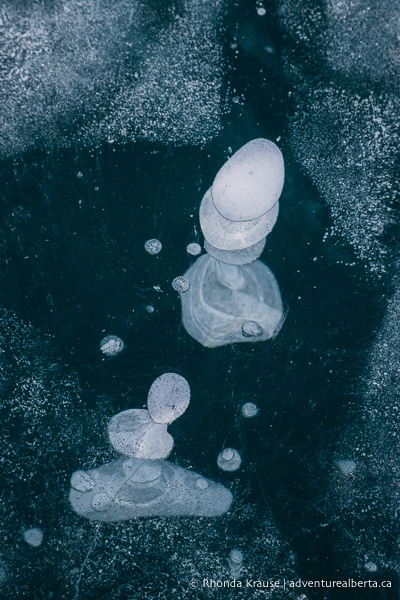
As Abraham Lake continues to freeze, stacks and layers of bubbles start to appear in the thickening ice. Soon the lake looks like a giant lava lamp, with icy blobs frozen in time.
.jpg)
Even though all lakes have organic matter decaying in their depths, what makes Abraham Lake such a special place to see frozen methane bubbles is the clarity of the ice and high concentration of bubbles. The wind gusts here can be very strong, blowing off snow and polishing the ice into a smooth, glass-like surface. Without a blanket of snow, thousands of frozen bubbles in Abraham Lake are revealed.
.jpg)
Best Time to See Frozen Methane Bubbles in Abraham Lake
The best time to see the Abraham Lake bubbles is typically from mid-January to early February. The lake is usually frozen by late December and a few weeks later the bubbles are at their best, having had some time to layer and freeze in thick ice.

Of course, there can be no guarantees when Abraham Lake will be frozen enough to safely walk on. When the lake freezes depends on the weather and how cold it’s been. If temperatures haven’t been cold enough, for a long enough period of time, the lake might not be frozen until mid-January. The lake’s ice coverage varies throughout the winter too, so just because one spot is frozen thick doesn’t mean everywhere is. In general, it’s best not to plan a trip to see the methane ice bubbles until January at the earliest.
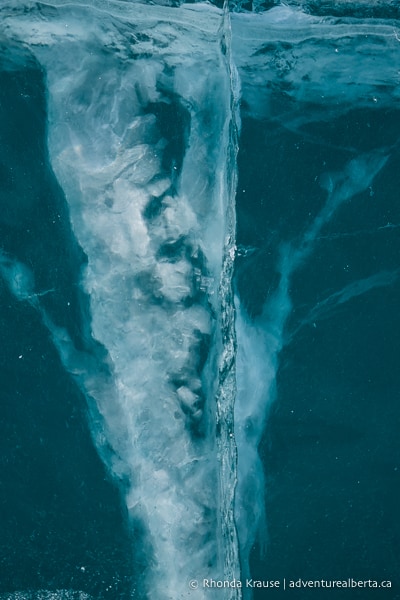
Another factor that affects the visibility of the bubbles is snow. If there’s been a recent snowfall the ice will be covered, especially if there hasn’t been a significant amount of wind.
.jpg)
Later in the winter there will likely be more snow both on the surface and frozen in the lake, affecting the clarity of the ice and concealing the bubbles. However, the ice-locked snow is just as beautiful as the bubbles, looking like spilled milk flowing over broken glass. The patterns are absolutely mesmerizing!
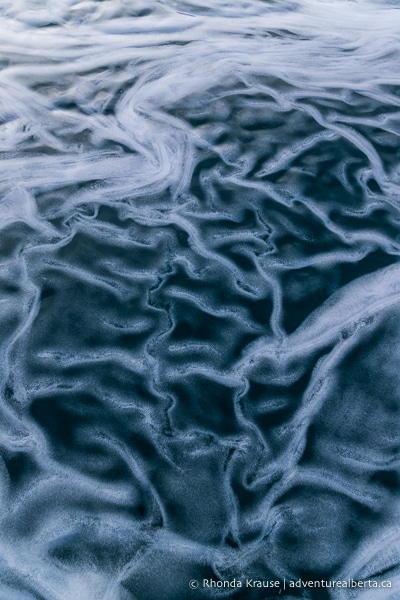
.jpg)
Best Places to See the Abraham Lake Ice Bubbles
There are several places to view the Abraham Lake ice bubbles that are easily accessible along the David Thompson Highway. You obviously need to find somewhere with a large surface of exposed ice, or at least patches that are snow free. These areas typically can be found south of Windy Point.

While it’s not necessarily hard to find some methane bubbles in the ice, the conditions do frequently change so the quality and quantity of the bubbles can’t be guaranteed.

Here are some places you’re most likely to find frozen methane bubbles in Abraham Lake. It’s best to visit a few different spots so you can see a variety of shapes, sizes, and patterns of bubbles, as well as different shades of blue in the water.
.jpg)
Preacher’s Point
Preacher’s Point is one of the most popular places to see frozen bubbles in Abraham Lake. Located at the far south end of the lake, Preacher’s Point has a large parking lot steps away from the lakeshore.
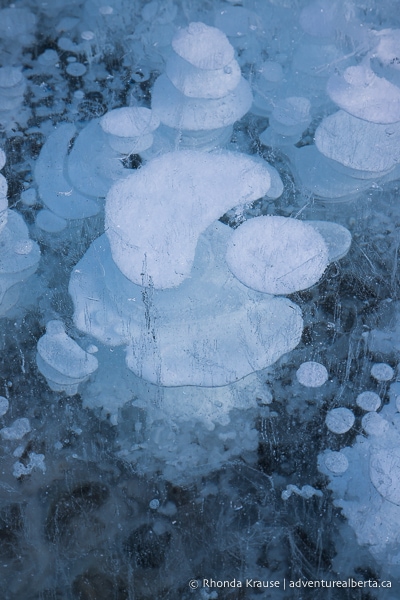
Since the water at Preacher’s Point is shallow in places, you can see bubbles along with rocks and grass on the lakebed. You may even spot some ice formations that look like coral. The ice here is also light blue, or even colourless, which is great for seeing the bottom of the lake.
.jpg)
A note of caution is that the North Saskatchewan River flows into Abraham Lake at Preacher’s Point so there is potential for weak spots in the ice. You may notice ice heaves or rounded ridges in places, especially against the shoreline.
The Belly of Abraham
The area between Hoodoo Creek and the turn off to the Cline Waste Transfer Station/Vision Quest Staging Area is one of the most photogenic places to see the Abraham Lake bubbles. Here you can snap a picture of the ice bubbles with Mount Michener in the background.

There typically is a high concentration of methane bubbles here so you should be able to find several dense groups of bubbles. Another great thing about this spot is that the bubbles can be quite large and the water nice and clear. Since the lake is deeper here than at the Preacher’s Point, the water is a dark blue-green which really makes the ice bubbles stand out.
.jpg)
There are a few good options to access the ice along the Belly of Abraham, but basically anywhere you can safely park and walk onto the lake will do.
Many people park on the side of the road a short distance south of Hoodoo Creek because it’s close to a beach you can walk onto the ice from. Another option is to continue past Hoodoo Creek until you see an unmarked gravel road heading towards the lake. Turn onto that and follow it down to the lake. This beach is a popular random camping spot in the summer.
.jpg)
Allstones Cove
Allstones Cove can be a nice spot to view the bubbles without having to go on the ice. From the parking lot at the Allstones Lake Staging Area you can look into the cove and see the bubbles from above, or walk down to the shore for a closer look. Since Allstones Creek flows into the lake here, it’s not recommended to go out on the ice.
.jpg)
Is Abraham Lake Safe in Winter?- How to Stay Safe on the Ice
Before venturing out on the ice in search of bubbles, you need to be aware of the inherent dangers and take steps to mitigate some of the risk.
No lakes are ever 100% safe, even in the winter. Abraham Lake is actually more dangerous than other lakes because it’s a man-made reservoir.
.jpg)
Since a dam controls the water level of Abraham Lake, it can rise and fall even after ice forms on the top. When there’s an air gap between the ice and water, the ice can break more easily. Someone who falls through might not be able to pull themselves out of the water because the ice is beyond reach (plus shock sets in from the cold).
It’s not advised to go on the lake between the dam and Windy Point because the ice is unstable here.
.jpg)
The Alberta Conservation Association recommends that ice be a minimum of 15 cm/6 inches thick before walking on it. You should also stay away from areas of moving water (like at the mouth of rivers and streams), avoid ice with large cracks or depressions, and stay off snow covered areas because they could be hiding weak ice.

If you’re walking on the ice, it’s safer to stay close to shore. Never go on the ice alone and carry a rope that can be used to rescue someone who falls through the ice.
Taking a few precautions and modelling common sense behaviour can make the bubble viewing safer for everyone.
.jpg)
Review of the Abraham Lake Bubbles
There’s a lot of hype around the Abraham Lake ice bubbles, but even a cynic questioning, “What’s the big deal, they’re just bubbles?” should be able to appreciate this exceptional phenomenon.
.jpg)
For such a simple activity, it’s surprisingly fun to look at bubbles in the ice and it’s definitely one of the more unique things to do in Alberta in winter. It’s also nice that you don’t need to buy a bunch of expensive gear to take part, like other winter activities.
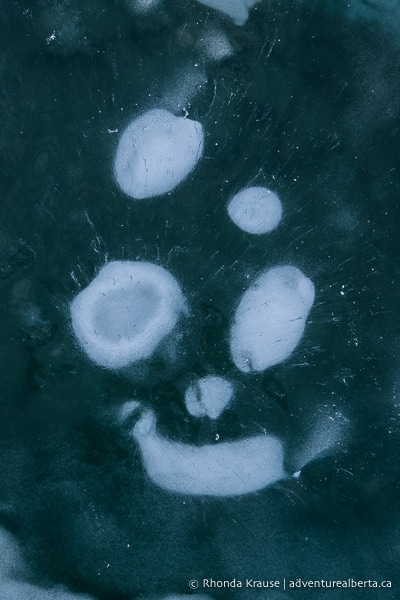
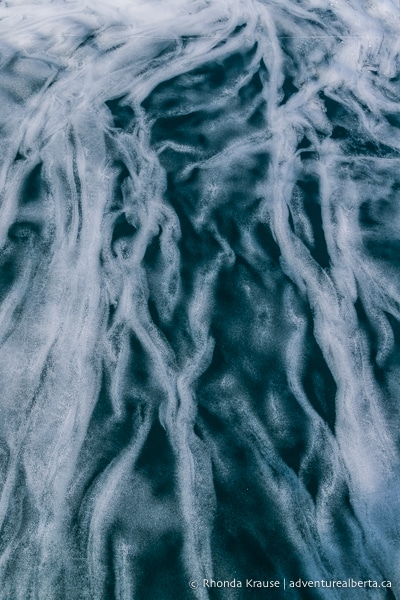
Even if you’re somehow not impressed by the bubbles themselves, or the other interesting patterns and formations in the ice, at least you’ll have spent the day surrounded by incredible scenery.
.jpg)
If you’re travelling a long way to see the ice bubbles, you should plan to visit some other winter attractions while you’re in the area. The Cline River Falls hike is close to Abraham Lake and takes you to a stunning frozen waterfall in a canyon. If you’d rather drive to a frozen waterfall, you could check out Crescent Falls.
.jpg)
Tips for Visiting Abraham Lake in Winter
Location: Abraham Lake is located in Clearwater County in west central Alberta. The lake stretches for 32 km along the David Thompson Highway between Nordegg and Banff National Park.
Getting There: If coming from Edmonton or Red Deer, you will pass through Rocky Mountain House and take Highway 11 (the David Thompson Highway) directly to Abraham Lake. If coming from Calgary, you can get there via Banff on Highway 1 and the Icefields Parkway. At Saskatchewan River Crossing turn right onto the David Thompson Highway. You could also come through Rocky Mountain House.
- For directions to the best bubble spots, put “Preacher’s Point” or “Abraham Lake Ice Bubbles Viewpoint” or “Hoodoo Creek” into Google Maps.
Facilities and Services: Abraham Lake is in a remote area and cell service is limited or non-existent in places. Some facilities and services on the David Thompson Highway that are available in summer are closed in the winter (this includes outhouses, accommodations, and gas stations). However, not everything is closed and in Nordegg you’ll find places where you can get gas, food, and spend the night.
What to Bring: Abraham Lake is known for being windy so dress in warm layers to prepare for a possible wind chill.
- The cold wind can kill your phone battery quickly so bring a backup power source, especially if you plan on taking a lot of pictures.
- Ice cleats come in handy for walking on the frozen lake. If you don’t have them wear boots with good grips.
- For safety, bring a rope with you onto the lake that can be used for rescue if someone falls through the ice. An extra set of clothes is a good idea too.
- You may also want to bring a shovel so you can clear off a patch of ice if the lake is covered in snow.
- Make sure your vehicle is prepared for winter driving conditions and has a winter emergency kit.
.jpg)
More Winter Guides
You may also enjoy these other Alberta winter activity guides:
- Alberta Ski Resorts- The Best Ski Areas in the Rockies
- Johnston Canyon Winter Hike- Banff National Park
- Things to Do in Edmonton in Winter- The Best Edmonton Winter Activities
- Ice Skating in Edmonton- The Best Edmonton Outdoor Skating Rinks
- Cross Country Skiing in Edmonton- A Guide to Edmonton’s Cross Country Ski Trails
- Things to Do at Pigeon Lake in Winter- The Best Pigeon Lake Activities for Winter Fun
Shop for Alberta & Adventure Themed Merchandise
Visit our store for more Alberta, nature, and adventure inspired products.

.jpg)
.jpg)
.jpg)
.jpg)
.jpg)
.jpg)


